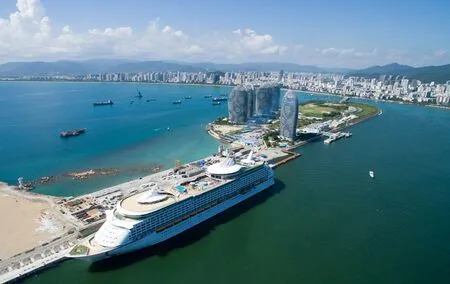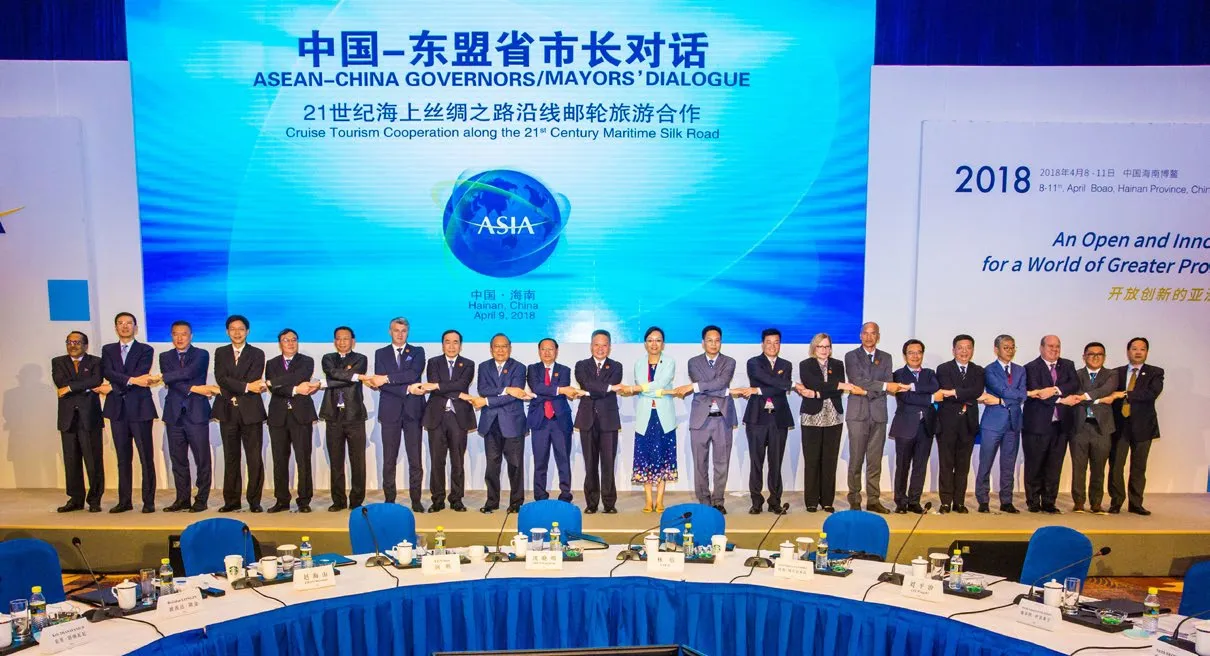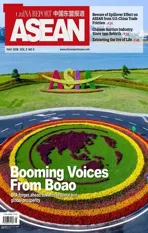CHINA-ASEAN CRUISE COOPERATION
2018-06-07ByWangFengjuan
By Wang Fengjuan
With development of the 21st Century Maritime Silk Road, many internationally renowned cruise companies have opened routes from China’s Hainan Province to ASEAN member states,bringing opportunities for the development of tourism. What is the next chapter of China-ASEAN cooperation in this area? As part of the Boao Forum for Asia Annual Conference 2018, this year’s ASEAN-China Governors/Mayors’ Dialogue was focused on cruise tourism cooperation along the 21st Century Maritime Silk Road.
Attractive Business Opportunity
As an important resort with a pleasant climate and unique culture, Hainan is endowed with great advantages for developing cruise tourism.
“The Province of Preah Sihanouk is home to Cambodia’s only deep seawater port and is strategically important for the development of the tourism industry in the province and the country,” revealed Governor of Preah Sihanouk Province Yun Min at the meeting. The province is designated as one of three economic development areas in Cambodia, with the other two in Siem Reap and Phnom Penh.By 2017, its port had received 35 liners, carrying a total of 35,448 visitors from countries including Vietnam, Thailand, Germany,the Netherlands and the United Kingdom.
An island province located at the southernmost tip of China, Hainan enjoys yearround warm weather similar to ASEAN countries, which is perfect for cruise activities.“The Chinese government has designated Hainan as an International Tourist Destination and identified the cruise industry as a pillar of Hainan’s tourism development, introducing a series of customized policy incentives for the island including visa-free entry and duty-free shopping,”said Governor of Hainan Province Shen Xiaoming in his speech during the Dialogue. In terms of infrastructure, Hainan’s Sanya Phoenix Island International Cruise Port already has an 80,000-ton berth and two 150,000-ton berths. Another 225,000-ton berth is scheduled for construction.Haikou Xiuying Port will also add several new cruise berths. It is estimated that by 2020, cruise terminals in Hainan will be able to receive a million passengers per year.
“The Philippines attaches great importance to the development of cruise tourism as a strategic product,” remarked Jose Chaves Alvarez, governor of Palawan Province, the Philippines. Now Palawan is exploring its potential for the cruise industry by building new ports, and its governor hopes all parties involved in the Dialogue will strengthen cooperation in this field.
35 liners 35,448visitors
By 2017, the port of Preah Sihanouk Province had received 35 liners,carrying a total of 35,448 visitors from countries including Vietnam, Thailand,Germany, the Netherlands and the United Kingdom.
As a popular tourist attraction,Phuket Province of Thailand has a history of more than 30 years in the development of cruise tourism. “Phuket is always ready to cooperate with other cities along the Maritime Silk Road to promote cruise tourism in terms of opening new routes and building liner networks,” said Deputy Governor of Phuket Snith Sriwihok.
“The cruise tourism industry is our greatest comparative advantage in the Beijing-Tianjin-Hebei Coordinated Development Program due to our vast customer market, rich tourism resources,comprehensive policies and sound supporting service system,”noted Vice Mayor of Tianjin Zhao Haishan.

On August 6,2016, Royal Caribbean’s Voyager of the Seas berths at Hainan’s Sanya Phoenix Island International Cruise Port.

Participants of the ASEAN-China Governors/Mayors’ Dialogue take a group photo after the meeting.
Cruise Tourism Alliance
In addition to governors and mayors from China and ASEAN member states, representatives from world-renowned cruise companies and cruise industry associations also attended the event. Participants of the Dialogue shared views on cruise tourism cooperation and reached consensus on strengthening partnership in this area.
During the meeting, attendees agreed to establish a Cruise Tourism Cities Alliance along the 21st Century Maritime Silk Road to promote the coordination of cruise industry development strategies of coastal cities in China and ASEAN countries,explore new fields in China-ASEAN tourism cooperation and create a more open and inclusive environment for regional development.
“As a new mode of cooperation in marine tourism, cruise tourism is developing rapidly and has driven the development of other related industries that have opened up great prospects for the cruise economy,” remarked Abdul Rashid Khan, chairman of Malaysia Cruise Industry Association. “As homeports and ports of call for cruise ships,coastal cities in ASEAN countries will be pioneers and beneficiaries of the cruise economy.”
Chairman of Carnival Corporation China Chen Ranfeng proposed that all parties involved fully utilize the mechanism of the Alliance to establish more convenient visa and clearance policies as well as favorable port policies for opening new routes.
“The future of China’s cruise industry is in the South China Sea, and the South China Sea will become one of the world’s top three cruise destinations alongside the Caribbean and Mediterranean,” declared Wu Qiang, executive deputy chairman of China Association of the National Shipbuilding Industry. To achieve this goal, all parties involved should accelerate construction of cruise homeports and improve port infrastructure.
In a speech at the meeting,Lin Yi, vice president of the Chinese People’s Association for Friendship with Foreign Countries (CPAFFC), highlighted the event “Presenting the China Story along the Maritime Silk Road” on Majestic Princess co-hosted by the CPAFFC and Carnival Group in May 2017.During the 37-day trip from Rome,Italy, to Xiamen, China, over 7,000 people from more than 40 countries experienced Chinese culture.
“I believe such events can also be carried out through the platform of the Cruise Tourism Cities Alliance,” opined Lin. “We also encourage provinces and cities to conduct more exchange in various forms to promote understanding and friendship and highlight the history of friendly exchange as well as recent stories of cooperation and development.”
“China can work with ASEAN countries along the Maritime Silk Road to develop Pan-South-China-Sea routes featuring unique island attractions such as circular routes starting from Hainan Island and passing major attractions in the Philippines,Cambodia and Thailand,”suggested Zhu Fuming, president of Genting Cruise Lines. “Such a route would not only take Chinese passengers out to visit those countries, but also bring ASEAN passengers to Hainan,promoting friendly ties between the peoples and building a winwin cruise economy circle.”
A Joint Initiative of the ASEANChina Governors/Mayors’ Dialogue was signed during the event.Participants reached a series of consensuses on cruise tourism cooperation including relaxing visa and entry policies, opening up cruise markets, sharing tourism resources and passenger sources and optimizing cruise routes. All parties involved will work together to realize the normalization of mechanisms for cruise tourism cooperation along the 21st Century Maritime Silk Road.
